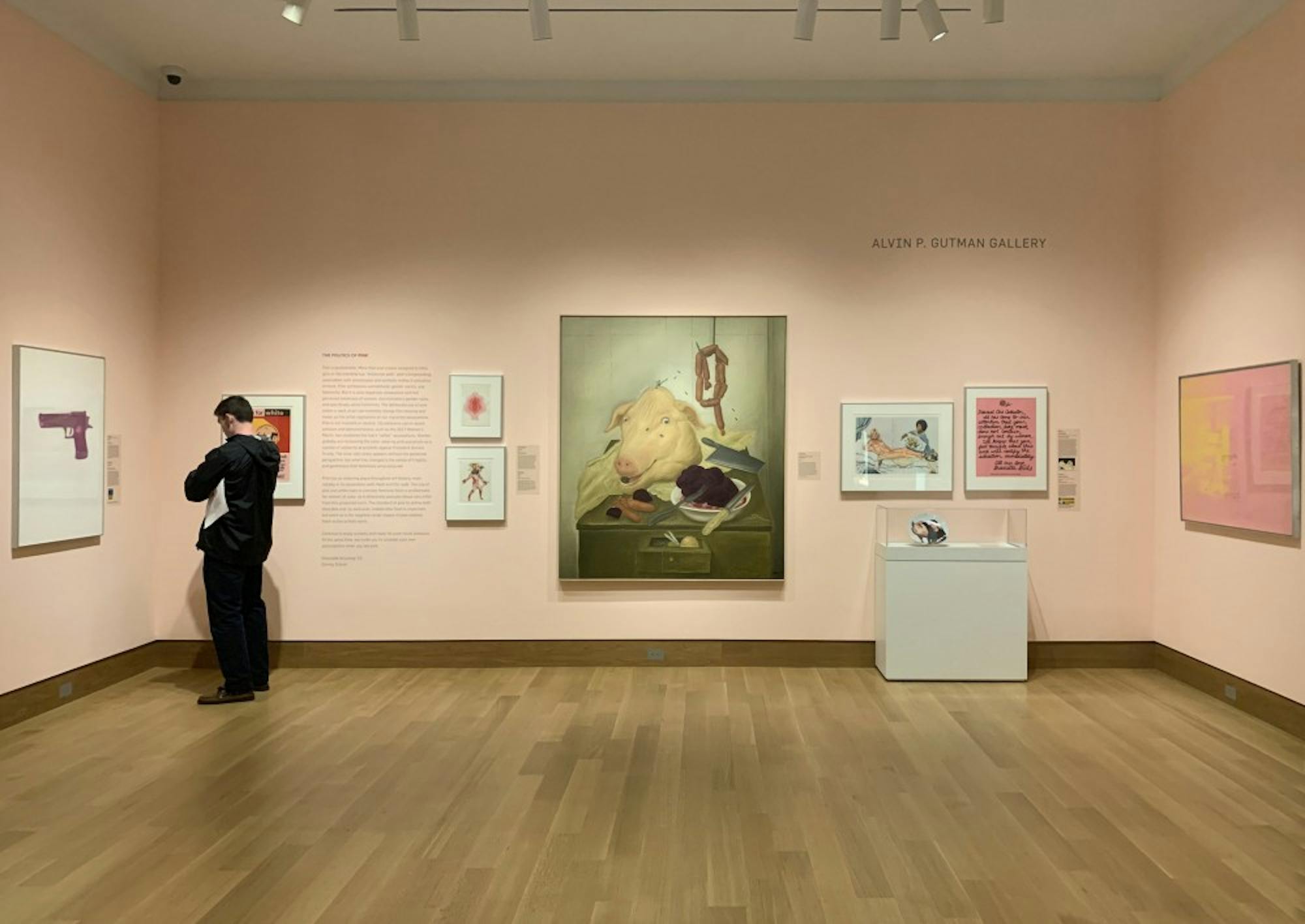When someone mentions the word “pink,” what images come to mind? Maybe you picture a little baby girl in her light-pink nursery, pink-frosted gender-reveal cakes or the new millennial pink that covers dorm rooms and stores across the country. Whatever you think of, it is most likely related to girls and traditional femininity.
“The Politics of Pink,” an exhibition created by Charlotte Grüssing ’19, currently on display at the Hood Museum of Art, takes inspiration from the association the color pink has to femininity, fragility, womanhood and the body in the past century, according to Grüssing.The exhibition is part of the “Space for Dialogue” program at the Hood Museum, which allows students to create exhibitions out of the permanent collection housed at Dartmouth.
According to Hood Museum associate curator of academic programming Amelia Kahl, Grüssing created experiences around art for Dartmouth’s campus during her work as a Conroy Intern throughout her senior year, which culminated in the curation and design of the “Politics of Pink” exhibition.
According to Grüssing, “The Politics of Pink” highlights the changing connotations of the color pink through the use of vibrant and colorful visuals.
“If a picture is worth a thousand words, then a color is worth a million,” Grüssing said.
Paul Hager ’22, who visited the exhibit, said he thought that Grüssing’s use of bright pink walls in the exhibition space draws viewers in and enraptures them with a combination of artwork and emotion that words cannot denote.
The exhibit features work that incorporates vibrant color and harsh, evocative imagery.
Among the featured artwork, “La Mesa del Carnicero (The Butcher Table)” by Fernando Botero depicts a fleshy, severed pig’s head, while “Pink Gun” by Maya Schindler depicts an object with typically masculine associations in pink. Andy Warhol’s “Electric Chair” illustrates an electric chair, another violent object, in pink and yellow. The usage of these contrasting imagery lends the exhibit a strangely inviting yet uncomfrotably gruesome character.
The dichotomy of the innocent nature of the color and the mature subject matter depicted in the artwork reflects the contrast and tension surrounding the color pink itself; it is inviting yet violent, innocent yet gruesome and beautiful yet powerful.
Why does the color pink evoke such strong connotations that other colors do not experience? According to Grüssing, throughout art history, pink has been used to depict the beauty and innocence of children and women. However, the usage of pink in “The Politics of Pink” translates to vulgar images of flesh that deviate from the Renaissance norm.
According to Grüssing, although pink was used in this innocent way to depict people beginning from the Renaissance, the color did not hold implications of gender as they do currently. In fact, infants were dressed in white — pink was often worn by men, and women would adorn blue gowns, Grüssing said.
Grüssing also described the history of the color which influenced her curation of the exhibition; the switching of so-called “masculine” and “feminine” colors was actually the result of marketers in the mid-19th century utilizing the blue and pink contrast to sell more gendered items and advertising soft pastel colors for women’s wear to contrast the neutral hues of men’s work uniforms. This simple marketing ploy had many unintentional harmful consequences as the initial connotation of innocence and purity rapidly changed into a symbol of oppression. The Nazis used pink to denote both homosexuals and rapists during the Holocaust, thus creating ties between this supposed innocent color and criminality, Grüssing said.
Despite the shift of pink’s association from innocence to oppression, in today’s complex political climate, pink has resurfaced as a color of strength and backlash in the feminist movement as seen in the fuscia pink p—hats worn to show solidarity and support for women’s rights and political resistance, again countering the purity and child-like emotions initially attributed to the color, Grüssing said.
Despite its contradictory history, the color pink is going through a major shift right now; according to Grüssing, with “gender fluidity and the rise of gay and drag culture in the media, people are becoming more cognizant of the color.”
Not only has pink started to face a transition in meaning and acceptance, but people are beginning to notice the color and its appearance across media thus inciting discussion on the politics of pink. According to Grüssing, millennial pink has taken over current modern style and art, and pink has started to become embraced as a symbol of strength and power among more than just women, but also on a global scale as people around the world are reclaiming and reimagining the connotations of the color pink.
How do you view the color pink? This simple question that Grüssing asks in “The Politics of Pink” holds a wide variety of complex, interdependent answers that give insight into the tense nature of the stereotypes that relate to the history of the color.
Grüssing said she hopes that people will leave the exhibit more cognizant of color and questioning its role in activism, race and gender perceptions.
“The Politics of Pink” will be on display at the Hood Museum until Nov. 3.


